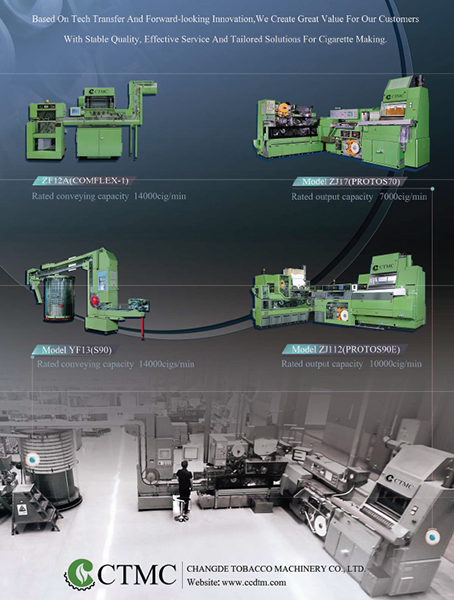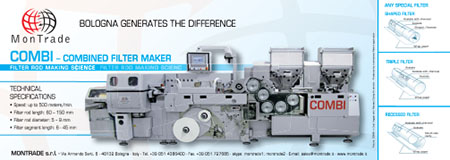
Stagnating tobacco consumption and a persisting pandemic are challenging the cigarette paper business.
By George Gay
It is obvious that the effects of Covid-19 have not been evenly spread across businesses and industries. Since lockdowns and restrictions became the norm, that part of your business that manufactures personal protective equipment will have done a lot better than the division that sells overseas holidays, and, generally, the tobacco sector sits somewhere between these extremes on the continuum of business opportunities and risks created by the disease and its underlying virus, SARS-CoV-2.
And if you zoom in a little closer, you will probably notice that there are pockets of activity within the tobacco sector that have fared better than others have. I would guess, for instance, that sales of tobacco products whose consumption does not require inhalation would have stood up better than those of others. But within other pockets of activity, Covid-19 has delivered only yet another injection of instability into businesses already faced with considerable changes and uncertainties brought about by those changes.
For a long time, the tobacco papers sector had been operating on a reasonably stable market, albeit one that was the subject of much consolidation among its business consumers and, therefore, among its suppliers. Of course, many sectors have found themselves affected by such consolidation, but, for the tobacco sector, no sooner had consolidation reached a point where little more was reasonably possible than those suppliers that had navigated these consolidations were hit by a major technological disruption.
Up to a point, that disruption, led by liquid-nicotine vapor devices, meant a partial reversal of the consolidation, so tobacco suppliers that could turn their activities toward the supply of liquid nicotine, and the suppliers of flavors, for instance, saw fresh opportunities open up.
But if you were in the paper business, this disruption offered no new opportunities only the threat of a further reduction in the demand for cigarettes and, by extension, a reduction in demand for plug wrap and cigarette and tipping papers. Even now, with the arrival on the market of heat-not-burn devices, the picture has not improved to any great extent for the paper sector. After all, if a pack of heat-not-burn cigarettes replaces a pack of traditional cigarettes, the amount of paper required goes down, though admittedly not to zero as is the case when traditional cigarettes are replaced by vapor devices.
Additional challenges
It goes without saying that the papers sector is being hit by the decline in cigarette smoking, a decline that is going to continue, but against that background, additional challenges have been and, to some extent, are being played out. And together, these challenges can be summed up in one word: uncertainty, which is perhaps one of the most despised words in the business lexicon. After all, even though the word “tax” has by no means a welcome ring about it, at least the inevitability of taxes raises them above the level of uncertainty.
Having said that, uncertainty, at some level, is ubiquitous in the business world, and, indeed, it can be the life blood of industries. Certainty does not breed disruption, and disruption seems to be what is currently being sought after in all but the most conservative industries. But there is a point where uncertainty tips over into negative territory, even chaos, and, as is described above, those operating in the tobacco sector have had to learn to live with high levels of uncertainty, especially in recent years. For instance, while it has been known for some time that smoking is in decline, trying to guess what level of decline is going to be experienced in the future is probably more difficult now than it has ever been, partly because we are living in a time of coronavirus.
And not only are markets for cigarettes declining, they are fragmenting with the appearance of a larger variety of products, some of them niche, a situation that translates into more but smaller orders for suppliers to tobacco manufacturers, such as those providing paper—in other words, a situation in which it is difficult if not impossible to maintain previous levels of efficiency. At the same time, the need to find solutions for the growing focus on cigarette litter is creating new demands in respect of filter-related papers.
There is no getting away from these challenges. Demand for combustible cigarettes will continue to decline while the demand for the special and niche papers needed to meet the requirements for new and reformulated products will continue to increase. The decline in demand for combustible cigarettes is likely to be driven by a number of factors but certainly in part by increases in demand for vapor devices and heat-not-burn products, especially now that the U.S. Food and Drug Administration (FDA) has authorized the marketing in the U.S. of IQOS as a modified-risk tobacco product.
But there is more to uncertainty than consumer-led demand. While laws and regulations on tobacco products differ from country to country and region to region, even within those countries and regions, regulations are subject to change as is clearly illustrated in the EU where the Tobacco Products Directive has the issue of change built into it. And while product preferences vary from country to country, such preferences are themselves the subject of change over time.
And these are just some of the challenges thrown up by uncertainties specific to the papers sector. Paper suppliers, of course, have also faced all the hurdles thrown up by the general restrictions introduced by governments in response to Covid-19.
Understandably enough, given that little was known about the SARS-CoV-2 virus when it first started to spread around the world, not all of these government responses have been consistent or coordinated, so, for instance, borders have been closed at short notice and some countries have reduced the number of border crossing points, causing long delays for commercial shipments.
Such closures and delays would have been difficult to deal with at any time, but they have been especially trying in the present circumstances when businesses along the tobacco products supply chain have been increasing orders from paper suppliers in an attempt to keep those chains well stocked as a buffer against other disruptions, such as the enforced short-term or long-term shutdown of factories. And to make matters worse, the challenge presented by trying to keep supply chains stocked can easily go into reverse. Once the increased orders have been filled and the supply chains well stocked, demand flattens until those stocks have worked through the system or until a new wave of factory closures and border restrictions set the whole disruptive process back into being.
The issues raised by Covid-19 have been considerable, and while some of them have been short-term, others are continuing. It is easy to forget that paper suppliers have had to respond to different customer ordering patterns and deal with new regulations and restrictions that differ from country to country and that can change from day to day, all while having to restructure their internal systems to deal with such things as working at home, video meetings and travel bans and restrictions.
Diversification
Given all of the above, it would be easy to become downbeat about the future for the tobacco paper industry and, therefore, those supplying it. After all, while it might be the case that paper suppliers are free to offset reductions in demand for tobacco product papers by seeking new markets beyond tobacco, such a strategy can come up against technological and commercial challenges. On one hand, it has to be asked whether a supplier’s machinery is capable of producing the grades of papers required by other industries, and, if not, if it is worth investing in the necessary machinery when there is no guarantee about success on the markets of these so-far-untapped industries.
And on the other hand, many paper suppliers are already diversified, offering papers across a number of industries, so, presumably, if making further inroads into these other markets was a simple matter, the suppliers would have done so already. In fact, such a strategy will be made more difficult by the fact that all of the paper suppliers currently engaged with tobacco will doubtless be looking into diversifying further into the same industries. As Albert Einstein is often quoted as having said: football is made more difficult by the existence of the other team.
But perhaps there is another avenue of “hope” opening up. I place “hope” in inverted commas here because it is based on something that not many people would hope for or welcome—the possibility that increasing numbers of vapers will be “encouraged” to return to smoking traditional cigarettes and increasing numbers of smokers will be discouraged from trying to move to vaping.
As I write this, the liquid-nicotine vapor industry in the U.S. is facing something approaching wipeout as the Sept. 9 deadline looms for applying to the FDA for premarket tobacco product authorization for vapor products—million-dollar authorization applications that are way beyond the means of small-sized and medium-sized companies.
At the same time, the U.K. government has decided to abolish Public Health England (PHE) next year. PHE, an executive agency of the department of health and social care, is the body that has been supportive of the vapor industry’s efforts to help in the effort to reduce cigarette consumption and is famously known for having declared vaping to be 95 percent less risky than smoking. Although another body will take over some of PHE’s responsibilities, no decision had been made at the time of writing about what would become of PHE’s anti-smoking efforts.
The trouble is, as Queen Elizabeth I reputedly said, “Hope is a good breakfast, but it is a bad supper.”














